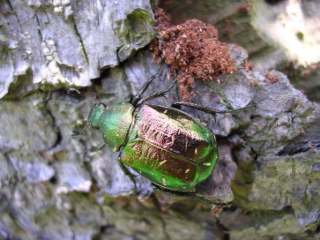Worcestershire Record No. 19 November 2005 pp. 28-29
NOBLE CHAFER GNORIMUS NOBILIS YET MORE RECORDS!
Harry Green
An issue of Worcestershire Record without mention of Noble Chafers is
highly unlikely these days! For more information please look at earlier issues
or the web site www.wbrc.co.uk.
Further survey work in 2005 has revealed several more orchards harbouring
these rare and important beetles. Typical frass and living larvae were found in
two orchards near Drakes Broughton. This find is particularly useful because
Kevin McGee has regularly seen flying beetles in that area so this year’s
evidence gives some indication of their breeding places. More recently
exploration of orchards near Cleeve Prior also revealed similar evidence,
although only in two decaying plum trees out of about 200.
Matt Smith undertook contract survey work in west Worcestershire for the
People’s Trust for Endangered Species (PTES) who are the lead partners in the
national Biodiversity Action Plan. He found a living beetle digging its way into
a decaying plum tree in one orchard and frass in trees elsewhere in the area.
We now have records scattered throughout much Worcestershire although many
areas remain to be explored, especially in central and NE parts of the county.
Are there Noble Chafers in the Redditch area? How far north does the range
extend in the centre of the county. Ideally every old orchard in the county
should be searched!
Nationally, further sites have been located in parts of west Gloucestershire
and of east Herefordshire. At the moment there appears to be a gap in
distribution between the north Gloucestershire population and those in south
Worcestershire. Matt Smith also re-found the beetles near Oxford in 2005 where
they have not been recorded for many years. To date none have been found in Kent
where they were once widespread. There is a small population in the New Forest
The accumulating evidence points to Worcestershire and parts of
Gloucestershire and Herefordshire being of national importance for this rare
beetle. In this area they have been found only in old orchards where the trees
show the right sort of heartwood rot. Old plums appear to be the most widely
used trees, followed by apple and cherry. Whether the beetle uses other species
of hardwood trees is unknown at present. Also we tend to search low down and who
knows what may be going on in decay high in trees?
Currently old orchards have very little protection for a conservation
viewpoint. Thousands of acres have been grubbed up over the last 50 years. Other
orchards become scrubland or woodland and these heavily shaded places are less
good for those invertebrates, like Noble Chafer, which like trees in the open
where the trunks are warmed by the sun. Current work is showing that old orchard
trees are providing important decaying wood habitat for invertebrates, as well
as being useful trees for nesting birds, epiphytic lichens, and as nectar and
pollen sources for many insects. Recent developments will hopefully lead to
grant-aided stewardship schemes aimed at orchard conservation and enhancement.
Re-planting is of course necessary in the long term especially if it is done
alongside decaying trees left in situ. There is of course considerable interest
in preserving old fruit tree varieties as standing trees and through propagation
by grafting.
Please keep looking for big green beetles! Also if you are aware of old
orchards which we may be able to examine for beetles please contact zen130501@zen.co.uk.
 |
Noble chafer Gnorimus nobilis
Picture by Matt Smith
The rear end of this
beetle was noticed sticking out from bark on a plum tree. It was apparently
burrowing into the decaying wood. Living larvae arising from this would of
course be very difficult to locate. It seems as if generations of beetles may
reproduce inside a decaying tree without the adult beetles emerging from the
tree. |
